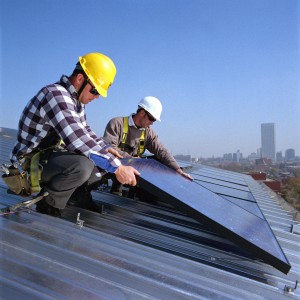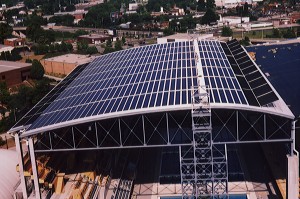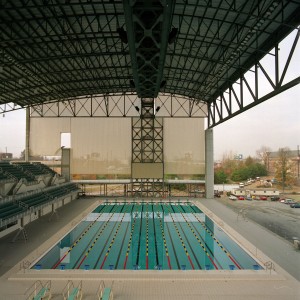One purpose of this blog is to share history that might otherwise be lost. In that spirit I offer the following piece (‘Green Energy at the Olympics’) that I drafted in 2012 but has not previously been published. It tells the story of the U.S. Department of Energy’s role in the 1996 Summer Olympic Games held in Atlanta, GA, and has been updated slightly for this Post. Atlanta was the site of the first ‘green Olympics’ and set a challenge that has been met in Olympics that followed. Also attached are photos from the Olympics site, showing some of the solar energy projects that were implemented.
Green Energy at the Olympics
With the London Summer Olympics of 2012 behind us and the Rio de Janeiro 2016 Summer Olympics coming into view, it is time to bring the record of greening the Olympics up to date.
The host British Government for the 2012 Games accepted the challenge to ‘green’ the Olympics and did an excellent job. BP, an official sponsor, announced that three of the company’s advanced biofuels (cellulosic ethanol, biodiesel, and biobutanol) “….will be demonstrated in approximately 100 fleet vehicles at the 2012 Olympics. …. By incorporating them in the fuels for London 2012 we have taken the next generation of biofuels from the laboratory to the road.” In addition, energy efficient, sustainable and recyclable facilities were designed and constructed, and a portion of the Olympic site’s electrical demand was met by solar panels.
These ‘green energy’ activities continued the theme of greening the Summer Olympics that started with the U.S. Department of Energy and Atlanta in 1996, and continued with Sydney in 2000, Athens in 2004, and Beijing in 2008.
When Atlanta was selected for the 1996 Summer Olympic Games it was understood that this was likely to be the last U.S. city to host the Summer Games until well into the next century. It was also recognized that the Olympics represented a highly visible and unique opportunity to showcase American energy efficiency and renewable energy technologies and ‘speak to the market’ directly. More than two million on-site visitors were expected in Atlanta, as well as a global TV audience of more than three billion. The 2012 TV audience for the London Games was even larger.
Planning for the U.S. Department of Energy’s activities at the 1996 Summer Games began in 1990 at DOE’s Atlanta Support Office, and took formal shape in March 1992. This is when the newly formed National Renewable Energy Laboratory and the Atlanta Support Office formed a team to identify and discuss opportunities with the Atlantic Committee for the Olympic Games (ACOG) and the Metropolitan Atlantic Olympic Games Authority (MAOGA). Technical opportunity teams were formed, and initial discussions with industry and other stakeholders began that fall.
Unfortunately, much of this planning got lost in the aftermath of the 1992 U.S. presidential election, the beginning of a new Administration, and the appointment of a new Secretary of Energy. When this became clear early in 1993 some of us decided to act and revive the effort as an ad hoc activity – no DOE funds had been budgeted for activities in Atlanta. Through a series of internal actions at DOE’s Office of Energy Efficiency and Renewable Energy and generous in-kind and cash contributions from private sector partners, a significant demonstration program was planned and implemented, with many ongoing benefits to Atlanta and to Georgia Tech where most of the athletic competitions were located.
What was accomplished?
– 40,000 square feet of the roof area of the newly-built swimming arena (Natatorium) were covered with 2,856 photovoltaic (PV) modules, delivering 340 kilowatts of peak electrical power to the swimming complex. At the time, and for several years afterwards, this was the largest PV building installation in the world.
– A 9 kilowatt peak PV array was mounted over the walkway to the Natatorium, which charged a battery storage unit to offset nighttime lighting electrical needs.
– 274 solar pool heating panels were also mounted on the Natatorium roof, to heat the one-million gallon Olympic pool.
– Several hundred alternative fuel vehicles, both buses and light duty vehicles, were used as part of the Olympic fleet. Fuel sources used included compressed natural gas, liquid natural gas, battery-stored electricity, and hydrogen.
– A stand-alone PV-powered outdoor lighting system (65 double-lamped fixtures) provided the illumination for the visitor parking lot of the newly built Martin Luther King, Jr. Visitor Center.
– A 7 kilowatt peak dish-engine, multi-faceted, concentrating solar power unit was on loan to Georgia Tech for demonstration during the Olympics.
– A local school roof was selected for installation of a highly reflecting ‘cool roof’ to reduce cooling requirements
– A building on the Georgia Tech campus and the newly built Southface Energy and Environmental Resource Center were selected as sites for geothermal heat pump demonstrations. The 6,000 square foot Center, located on land leased from the City of Atlanta and next to the City’s Science Museum, was built with DOE funds as a demonstration site for current or emerging energy efficiency and renewable energy technologies for the building sector.
It is anticipated that the greening of future Olympics, both Summer and Winter, will continue and serve as an expanding showcase to the world of what can be done with green energy. We have come a long way since 1996, with many green energy technologies entering the global energy mainstream and beginning to take their place in our energy future. Demonstration at the Olympic Games and other public events can hasten this inevitable and critical development.
Photos (in order): installing solar panels on Natatorium roof; Natatorium roof (PV + water heating); Olympic pool under solar roof; installing the reflective ‘cool roof’








